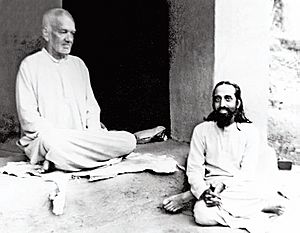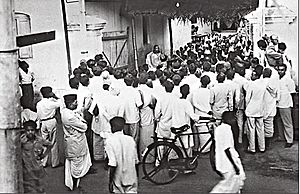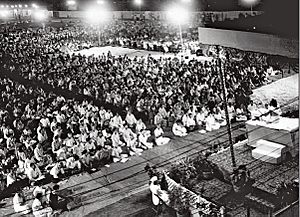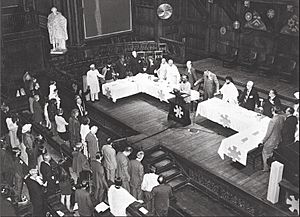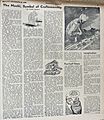Chinmayananda Saraswati facts for kids
Quick facts for kids Chinmayananda |
|
|---|---|

A portrait of Chinmayananda in 1990
|
|
| Birth Date | 8 May 1916 Ernakulam, Cochin Princely State, British India (Present Day :Kerala) |
| Died on | 3 August 1993 (aged 77) San Diego, California, U.S. Resting place: Sidhbari |
| Birth name | Balakrishna Menon |
| Guru/teacher | Sivananda Saraswati Tapovan Maharaj |
| Philosophy | Advaita Vedanta |
- "The tragedy of human history is that there is decreasing happiness in the midst of increasing comforts."
- "The real guru is the pure intellect within; and the purified, deeply aspiring mind is the disciple."
- "We may often give without love, but we can never love without giving."
Swami Chinmayananda Saraswati, often called Swami Chinmayananda, was born Balakrishna Menon on May 8, 1916. He was a respected Hindu spiritual teacher. He started the Chinmaya Mission, a global group that teaches about Advaita Vedanta, the Bhagavad Gita, and other old Hindu texts.
Starting in 1951, he helped bring back Hindu spiritual and cultural traditions around the world. He made ancient religious texts easier to understand by teaching them in English in India and other countries. The Chinmaya Mission is a spiritual, educational, and charity group with over 300 centers. Swami Chinmayananda wrote 95 books, including explanations of important Hindu scriptures. He also taught Indian philosophy at many universities.
Contents
Biography
Early Life and Education
Balakrishna Menon, who later became Swami Chinmayananda, was born in Ernakulam, Kerala, India, on May 8, 1916. He was the oldest son of a well-known judge. His mother passed away when he was young.
He went to school in Kochi and Thrissur. He earned his first college degrees from Maharaja's College in Ernakulam and St. Thomas College in Thrissur. Later, he studied literature and law at Lucknow University. Even though he became a spiritual teacher, he wasn't very religious as a student. In 1936, he visited a wise man named Sri Ramana Maharshi. Swami Chinmayananda later said he felt a spiritual spark during this visit. He also learned a lot from Tapovan Maharaj in Uttarkashi.
Joining the Indian Freedom Fight
In 1942, India was trying to gain independence from British rule. Balan joined students who wrote and shared flyers to encourage national pride. An arrest warrant was issued for him. He went into hiding for a year, moving around to avoid British officials.
In 1944, he was arrested in Punjab for helping freedom groups. He spent months in prison in poor conditions and became very sick. He was left by the roadside, but a kind Indian Christian woman found him. She took him in and helped him get to a hospital, saving his life.
Working as a Journalist
After getting better, Balan started working as a journalist for The National Herald. This newspaper was started by Jawaharlal Nehru. He wrote articles about the need for fairness in society and covered many topics. His articles, like "In Praise of the Postman," made him known for his strong opinions. In 1947, he started writing for The Commonweal.
Studying Vedanta
While working as a journalist, Balan visited Swami Sivananda's ashram in Rishikesh. He went there to write an article about spiritual teachers. He later said he wanted to see "how the swamis were keeping up the bluff."
But at the ashram, his views changed. At 31, he became a spiritual enthusiast and then a monk. He started reading Hindu scriptures and spiritual books. Swami Sivananda saw his potential and asked him to help with a Gita Committee. On February 25, 1949, Balan became a monk and was given the name Swami Chinmayananda. This name means "bliss of pure Consciousness."
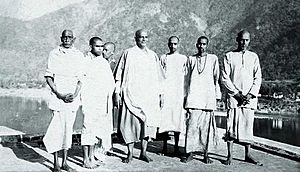
With Swami Sivananda's blessing, Chinmayananda went to study with Tapovan Maharaj, a great Vedanta teacher in Uttarkashi. For several years, he lived a very simple life and deeply studied the scriptures.
Starting a Spiritual Movement
In 1951, Swami Chinmayananda decided to share the teachings of Vedanta with everyone. Traditionally, this knowledge was only for certain groups. He left the Himalayas to travel across India. He wanted to see how Hindu teachings were being shared. He felt disappointed and realized he needed to teach the wisdom of the Upanishads through lecture series.
His first lecture series was in Pune in December 1951. His audience quickly grew from a few people to thousands. People from all walks of life attended and participated.
Chinmaya Mission
After a lecture series in Madras in 1953, some people wanted to create a group to study Vedanta. Swami Chinmayananda agreed, but he didn't want it named after him. He said he was there to share the wisdom, not to be famous.
The group explained that "Chinmaya" also means "pure Knowledge" in Sanskrit. So, he agreed. On August 8, 1953, the Chinmaya Mission was officially formed. Soon, hundreds of study groups were created across India. People met to study religion and philosophy. Special groups for women, called Devi groups, were also formed for spiritual study and social work.
In 1956, the President of India, Rajendra Prasad, opened a lecture series by Chinmayananda in Delhi. He praised Swami Chinmayananda's work to bring back India's cultural pride. In just five years, Swami Chinmayananda had taught over 50,000 people.
On March 6, 1965, Swami Chinmayananda began his first global teaching tour. He visited 39 cities in 18 countries, including the United States and the United Kingdom. For the next 28 years, he continued these international talks. He would stay for about a week in each place, giving many lectures and meeting with people.
As the spiritual movement grew in the United States, Chinmaya Mission West was formed in 1975 to help organize it. Swami Chinmayananda's message also connected with leaders of other religions. He supported talking with people of different faiths and took part in many interfaith events. In 1992, he gave lectures at twelve US universities to help start the Chinmaya International Foundation in Kerala, India.
Vishva Hindu Parishad
In 1963, Swami Chinmayananda suggested creating a World Hindu Council. This council would bring together people from around the world to discuss how to help Hindu culture grow. This idea interested S. S. Apte, who had similar thoughts.
Together, Swami Chinmayananda and Apte organized a conference in August 1964. This meeting led to the creation of the Vishva Hindu Parishad (VHP). Swami Chinmayananda was chosen as its president. He believed the VHP should help Hindus understand their important place in the world. He also felt it should teach Hindus living abroad about their culture and spiritual values.
Death
Swami Chinmayananda had heart problems for many years. He had his first heart attack in 1969. In 1980, he had heart bypass surgery in the United States. On July 26, 1993, he had breathing problems in San Diego, California. He had emergency heart surgery, but his condition remained serious. He passed away on August 3, 1993, at the age of 77. His followers believe this was the day he achieved mahasamadhi, a spiritual passing.
On August 7, 1993, thousands of people were at the airport in New Delhi when his body returned to India. He was laid to rest in Sidhbari, Himachal Pradesh, following traditional rituals. A special shrine has been built there.
Tribute
On December 24, 1991, forty years after his first lecture series, Swami Chinmayananda's followers in Mumbai honored him. They gave him an amount of gold equal to his body weight in a special ceremony. The money raised from this was used to support the many projects and programs of the Chinmaya Mission.
Legacy
Chinmaya Mission's Work
Swami Chinmayananda created ashrams around the world. These are places for spiritual quiet time, study, and practice. The Chinmaya Mission continues many projects in his memory. These include:
- Bala Vihar: Classes for children to learn about Hindu culture and values.
- Chinmaya Yuva Kendra (CHYK): A global youth group for young people.
- Chinmaya Study Groups: Groups for adults to study religion and philosophy. These are also called Devi Groups.
The Mission has also built over 58 temples and runs the Chinmaya Organisation for Rural Development (CORD). CORD helps poor people in rural areas become self-sufficient.
Chinmaya International Foundation
He also started the Chinmaya International Foundation. This foundation is located in the ancestral home of Adi Shankara, a famous ancient Indian philosopher, in Kerala, India.
Chinmaya Schools
In 1965, the first Chinmaya nursery school opened in Kollengode, Kerala. Today, there are over 76 Chinmaya Vidyalayas (schools), seven Chinmaya colleges, and the Chinmaya International Residential School in India. There is also a Chinmaya Vidyalaya in Trinidad, outside of India.
Medical Facilities
Swami Chinmayananda opened the Chinmaya Mission Hospital in 1970. It has grown into a modern, 200-bed hospital in Bangalore, India. In the late 1970s, he also set up health care services in rural areas of Sidhbari, Himachal Pradesh.
Publications
Swami Chinmayananda wrote 95 books during his life. These include 40 explanations of classic religious texts and many original works. His commentary on the Bhagavad-gita became very popular. His books, originally in English, have been translated into many Indian languages and even French.
BMI Chart
The BMI (Body Mind Intellect) Chart is a special teaching tool created by Swami Chinmayananda. It helps explain human experiences using the ideas of Vedanta, using letters from the English and Devanagari alphabets.
Honors and Recognition
On December 2, 1992, Swami Chinmayananda spoke at the United Nations about "Planet in Crisis." The US magazine, Hinduism Today, gave him the Hindu Renaissance Award and named him "Hindu of the Year" in 1992.
In 1993, he was chosen as "President of Hindu Religion" for a big conference in Chicago. This was the same place where Swami Vivekananda had given a famous speech 100 years earlier. He was also going to be honored for his service to humanity at another conference. However, he passed away before attending these events.
On May 8, 2015, the Prime Minister of India, Narendra Modi, released a special coin to celebrate Swami Chinmayananda's 100th birth anniversary.
Images for kids
See also
 In Spanish: Chinmayananda para niños
In Spanish: Chinmayananda para niños


